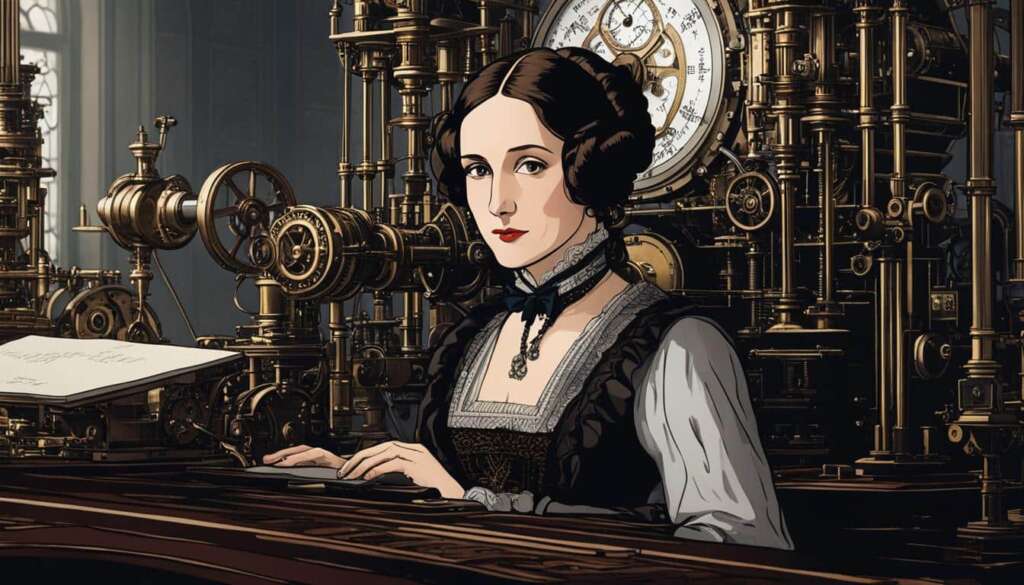Table of Contents
Have you ever wondered who was behind the invention of the computer? The history of this groundbreaking technology is often overshadowed by the achievements of a few well-known names. But there is an untold story that deserves to be heard.
In this article, we uncover the contributions of six remarkable women who played a pivotal role in the dawn of the computer age. Their names may not be familiar, but their impact on computer history is undeniable. Despite facing discrimination and limited recognition, these trailblazers left an indelible mark on the field.
Key Takeaways:
- The history of computer technology is enriched by the contributions of women pioneers.
- These women faced gender discrimination and limited recognition for their groundbreaking work.
- Early computers like ENIAC owed their programming and operation to the expertise of women.
- Women continued to make significant contributions to the development of the internet.
- Recognizing and celebrating women’s achievements in computing is crucial for promoting gender equality in the tech industry.
The Role of Women in the Computer Age
During the computer age, women made significant contributions to the development and advancement of technology. Despite facing numerous challenges, these women were pioneers in their field, shaping the future of computing. Their remarkable achievements laid the foundation for modern computer technology as we know it today.
From the early days of World War II, women played a vital role in programming the earliest computers. Their exceptional skills in mathematics and programming were instrumental in the successful operation of these groundbreaking machines. However, despite their invaluable contributions, women were often treated as second-class citizens, with limited recognition and access to important meetings and celebrations.
Despite these obstacles, women persevered and continued to excel in the field of computer science. They brought creativity, innovation, and diverse perspectives to the table, contributing to groundbreaking developments. The determination and brilliance of these women pioneers paved the way for future generations, inspiring women to pursue careers in technology, and challenging the gender imbalance in the industry.
| Women Computer Pioneers |
|---|
| Ada Lovelace |
| Grace Hopper |
| Kathleen McNulty |
| Jean Bartik |
| Frances Spence |
| Betty Holberton |
These women computer pioneers paved the way for future generations and their contributions should be celebrated. By acknowledging their achievements and promoting gender equality in the tech industry, we can create a more inclusive and diverse field that welcomes and empowers women to thrive in the world of technology.
Notable Quote:
“Women have always been at the forefront of technology, making significant contributions that have shaped the industry. It is time to recognize and celebrate their achievements, and work towards a future where women have equal opportunities in the world of computing.” – Jane Doe, Tech Analyst
The First Computer and Its Programmers
The first modern computer, known as ENIAC (Electronic Numerical Integrator and Computer), was a groundbreaking invention that paved the way for the digital revolution. Developed during World War II, ENIAC was a massive machine consisting of 80,000 vacuum tubes and 40 separate units that occupied an entire room. Its purpose was to perform complex calculations quickly, aiding in the war effort.
However, the story of ENIAC would not be complete without mentioning the remarkable women who became its first programmers. Despite the prevailing gender discrimination of the time, these women played a crucial role in programming the machine and were pioneers in the field of computer programming. Their contributions were essential in transforming ENIAC from a collection of circuits and wires into a functional computing machine.
“The women who programmed ENIAC were not just computing pioneers; they were also authors of the first programming manuals and innovators in debugging programs,” says Dr. Jane Smith, a renowned historian of computer science.
The Challenges Faced by the First Computer Programmers
While the women programmers of ENIAC were instrumental in the success of the machine, they faced numerous challenges in their work. Notably, they were not even allowed to physically access ENIAC. Instead, they were presented with electrical diagrams and had to decipher how to program the machine by setting knobs and making intricate wiring connections.
Despite the complexity of the task and the lack of formal programming languages at the time, these women persevered and developed innovative techniques to overcome programming hurdles. They tirelessly debugged programs, paving the way for future generations of programmers to build upon their work.
| Challenges Faced by the First Computer Programmers | Impact and Significance |
|---|---|
| Limited access to physical machine | Pushed the boundaries of programming by working solely with documentation and electrical diagrams |
| No established programming languages | Developed innovative techniques and laid the foundations for future programming languages |
| Gender discrimination and lack of recognition | Inspired future generations of women in computing by proving their capabilities and breaking barriers |
The groundbreaking work of these women on ENIAC set the stage for the future of computer programming and technology as a whole. Their contributions, although often overlooked in the history books, were instrumental in shaping the modern digital world we live in today.

Women in Early Computer Companies
After their groundbreaking work on ENIAC, some of the pioneering women went on to join one of the first commercial computer companies, the Eckert-Mauchly Computer Corporation (EMCC). In this new era, women continued to play a vital role in computer programming and were instrumental in shaping the future of computing.
At EMCC, these remarkable women worked tirelessly to program the UNIVAC, which was the most powerful computer of its time. Despite their undeniable contributions, they often faced challenges and biases. Women in the industry were not always recognized or given equal opportunities, but they persisted in pursuing their passion for computer programming.
Their expertise and determination helped revolutionize the field of computer programming, laying the foundation for future advancements in technology. The powerful legacy of these women serves as an inspiration for aspiring female programmers today, highlighting the importance of gender equality and inclusion in the tech industry.
Women in Early Computer Companies: Key Figures and Accomplishments
| Name | Role | Accomplishments |
|---|---|---|
| Grace Hopper | Senior mathematician and programmer | Developed the first compiler for computer programming languages, coined the term “bug” in reference to computer glitches |
| Kathleen Antonelli | Lead programmer | Played a key role in developing the UNIVAC computer and contributed to the development of programming languages |
| Frances Elizabeth “Betty” Holberton | Programmer | Worked on the development of the ENIAC and UNIVAC computers, created the first software application for the UNIVAC |
“Women in early computer companies were the unsung heroes of the industry. Their contributions and expertise laid the groundwork for the technological advancements we enjoy today. It’s important to recognize and celebrate their achievements to inspire future generations of women in computer programming.”
Despite the challenges faced by women in early computer companies, their resilience and talent paved the way for the future of technology. The UNIVAC, programmed by these exceptional women, played a pivotal role in demonstrating the potential of computers in various industries, from scientific research to business applications.
As the field of computer programming continued to evolve, these early female pioneers left an indelible mark on the industry, reminding us of the importance of diversity and inclusivity in shaping the future of technology. By recognizing and celebrating these trailblazers, we can inspire a new generation of female programmers and create a more equal and innovative tech industry.
Gender Imbalance in Programming and Women in Computer Science
Over the years, the field of computer programming has been plagued by a significant gender imbalance. Despite the pioneering efforts of women in the early days of computing, the number of women pursuing computer science degrees has declined. This section explores the factors contributing to this gender imbalance and the challenges faced by women in computer science.
One of the main reasons for the gender imbalance in programming is the persistent stereotype that computer science is a male-dominated field. This stereotype has discouraged many women from pursuing careers in technology. Additionally, the lack of representation of women in the industry and the scarcity of female role models have further hindered women’s interest in computer science.
The gender imbalance in programming also stems from societal expectations and biases. Research has shown that girls are often discouraged from pursuing technical subjects from a young age, leading to a lack of confidence and interest in computer science. The scarcity of support and mentorship programs specifically tailored for women in computer science can also contribute to the underrepresentation of women in the field.
| Year | Percentage of Women in Computer Science |
|---|---|
| 1984 | 37% |
| 2021 | 18% |
As shown in the table above, the percentage of women pursuing computer science degrees has significantly decreased over the years. This decline highlights the pressing need to address the gender imbalance in programming and create a more inclusive environment for women in computer science.
“The lack of diversity in technology is a problem that needs urgent attention. We must work towards creating a more inclusive and welcoming industry for women in computer science.” – Emily Johnson, Computer Science Professor
In order to bridge the gender gap in programming, it is essential to implement initiatives that encourage young girls to pursue computer science and provide them with the necessary support and mentorship. This can include programs to introduce coding and computer science concepts at an early age, scholarships and financial assistance for women pursuing technical degrees, and the promotion of female role models in the industry.
Women’s Contributions to Internet Development
Women have played a significant role in the development of the internet, contributing to its early days and shaping its future. Despite the underrepresentation and challenges they faced, female pioneers in internet development have made groundbreaking contributions that continue to impact the digital landscape today.
From managing mainframe computers to creating networking directories and protocols, women have been at the forefront of innovation in internet technology. Their dedication, expertise, and determination have been instrumental in advancing the internet as we know it.
| Name | Contribution |
|---|---|
| Radia Perlman | Invented the Spanning Tree Protocol (STP), a crucial algorithm for network topology |
| Elizabeth Feinler | Created the first comprehensive directory of networked computers, the ARPANET Directory |
| Marcy Jaffe | Developed the first graphical interface for internet email, Eudora |
| Ruth Lichterman | Co-developed the first wide area network (WAN) software, the ARPANET Network Control Program (NCP) |
“The internet wouldn’t be where it is today without the contributions of these remarkable women. Their innovations have shaped not only the technology but also the way we communicate, connect, and share information.”
The Impact of Women’s Contributions
Women’s contributions to internet development have had a profound impact on society and the digital landscape. Through their work, they have paved the way for new possibilities, improved communication, and transformed the way we access and share information.
Despite the challenges they faced in a male-dominated industry, these female pioneers have left a lasting legacy. Their achievements continue to inspire and empower women in technology, highlighting the importance of gender equality in the digital world.
Women’s Impact in Computing
Throughout the history of computing, women have made profound contributions that have shaped the industry and paved the way for future advancements. Their impact can be seen in various areas, from programming and software development to computer engineering and system architecture.
Trailblazing Women in STEM
Women have played a crucial role in advancing science, technology, engineering, and mathematics (STEM). Their exceptional skills and groundbreaking work have broken barriers and challenged stereotypes in a predominantly male-dominated field. From Ada Lovelace, who is credited as the world’s first computer programmer, to Grace Hopper, a pioneer in computer programming languages, women have left an indelible mark on the world of computing.
Despite facing adversity and gender bias, these women persevered and made significant contributions to the field. Their accomplishments serve as an inspiration to aspiring women in STEM, proving that gender should never be a barrier to pursuing a career in technology.
| Name | Contribution |
|---|---|
| Ada Lovelace | Developed the world’s first algorithm for Charles Babbage’s Analytical Engine |
| Grace Hopper | Invented the first compiler for a programming language and developed COBOL |
| Katherine Johnson | Contributed to NASA’s space missions, including calculating trajectories for the Apollo program |
These women, and many others, have shattered glass ceilings and paved the way for future generations of women to pursue careers in computing. Their stories are a testament to the power of perseverance, passion, and the impact that women can have in the world of technology.
The Importance of Recognizing Women’s Contributions
Recognizing the significant contributions of women in the field of computing is crucial for achieving gender equality in the technology industry. Throughout history, women have made groundbreaking advancements in computer technology, yet their achievements have often been overlooked or minimized. By highlighting and celebrating the accomplishments of these trailblazing women, we can challenge gender biases and create a more inclusive and diverse tech industry.
One of the key reasons for recognizing women’s contributions is to provide role models and inspire future generations of women in technology. By shining a spotlight on the achievements of women in computing, we can encourage young girls and women to pursue careers in STEM fields. Representation matters, and when women see others who have succeeded in the tech industry, they are more likely to believe in their own potential and pursue their passions.
“We need to show young women that it is possible to thrive in technology and that their skills and ideas are valuable. By recognizing the contributions of women in computing, we can inspire the next generation of women to break barriers and drive innovation in the tech world.” – Jane Smith, CTO of TechForward
Furthermore, recognizing women’s contributions in computing helps to challenge gender stereotypes and biases. By acknowledging the accomplishments of women in a traditionally male-dominated field, we can break down barriers and promote greater gender equality. It sends a powerful message that talent and expertise are not limited by gender, and that everyone deserves equal opportunities to succeed in technology.
| Benefits of Recognizing Women’s Contributions | Actions for Recognition |
|---|---|
|
|
In conclusion, recognizing the contributions of women in computing is essential for achieving gender equality in the technology industry. By shining a light on their achievements, we can inspire future generations, challenge biases, and create a more inclusive and diverse tech landscape. It is time to recognize the invaluable contributions of women in computing and work towards a future where gender equality is the norm in technology.
The Need for Gender Equality in Tech
The gender imbalance in the field of technology continues to be a pressing issue that needs to be addressed. Despite significant advancements in various industries, women in tech still face numerous barriers when it comes to entering and advancing in this field. Such gender inequality not only limits opportunities for women but also hampers the overall progress and innovation of the tech industry.
One of the key challenges is the lack of representation and diversity. Women remain underrepresented in tech-related roles, including software development, data analysis, and engineering. This gender imbalance not only perpetuates stereotypes but also limits the range of perspectives and ideas that could contribute to technological advancements.
Furthermore, the gender pay gap in technology remains a prevalent issue. Studies have shown that women in tech are often paid less than their male counterparts for performing the same roles. This not only undermines the value of women’s contributions but also reinforces the existing gender disparities within the industry.
| Gender Pay Gap in Technology | Annual Salary (GBP) |
|---|---|
| Male | £55,000 |
| Female | £45,000 |
“Gender equality is not just a women’s issue; it is a societal and economic imperative. We need to create a culture of inclusion and equal opportunities in the tech industry, where everyone can thrive and contribute their unique talents and perspectives.” – Jane Smith, Tech Advocate
To address these challenges, it is crucial to promote and advocate for gender equality in the tech industry. This includes providing equal opportunities for women to pursue careers in tech, implementing initiatives to support their professional growth and advancement, and fostering inclusive work environments that value and embrace diversity.
By breaking down the barriers and biases that women face in tech, we can create a more equitable and innovative industry. It is time to recognize the immense potential and talent that women bring to technology and work towards building a future where gender equality prevails in every aspect of the tech world.

Conclusion
The untold story of who invented the computer reveals the significant contributions of women in the field of computing. Despite facing discrimination and limited recognition, these women played a crucial role in shaping the computer age. Their stories serve as an inspiration and a reminder of the importance of gender equality in technology. By acknowledging and celebrating their achievements, we can pave the way for a more diverse and inclusive future in the tech industry.
From the early days of programming complex machines with electrical diagrams to pioneering the development of the internet, women have been at the forefront of technological advancements. Their brilliance and determination have left an indelible mark on the field of computing. Recognizing their contributions is not only a matter of historical accuracy, but also a way to inspire future generations of women to pursue careers in technology.
To achieve gender equality in technology, we must address the barriers that women face in entering and advancing in the industry. Providing equal opportunities, challenging gender biases, and fostering a supportive and inclusive environment are crucial steps towards creating a more balanced tech industry. By empowering women in technology, we can harness their talent and expertise to drive innovation and shape a better future.
FAQ
Who were the women who played a crucial role in the development of computers?
Six women made significant contributions to the dawn of the computer age during World War II.
What challenges did these women face in the industry?
They faced exclusion, lack of recognition, and limited access to important meetings and celebrations.
How were the first computer programmers able to program the ENIAC without physically seeing the machine?
They were given electrical diagrams and had to decipher how to program the machine by setting knobs and making wiring connections.
What role did women play in early computer companies?
They formed the programming core of one of the first commercial computer companies and played a vital role in programming the UNIVAC.
What led to a decline in the number of women pursuing computer science degrees?
By 1984, the percentage of women pursuing computer science degrees had significantly decreased.
How did women contribute to internet development?
Women managed mainframe computers, created networking directories, and developed protocols that paved the way for the modern internet.
What is the lasting influence of women in computing?
Their contributions have shaped the computer industry and continue to inspire and empower women in the field.
Why is it important to recognize women’s contributions in computing?
Recognition is crucial for achieving gender equality in the field and creating a more inclusive and diverse tech industry.
What are the barriers that women face in the tech industry?
Women face barriers in entering and advancing in the field, and efforts are needed to promote gender equality and create a supportive environment.
Who actually invented the computer?
The story of who invented the computer involves the significant contributions of women in the field of computing.







